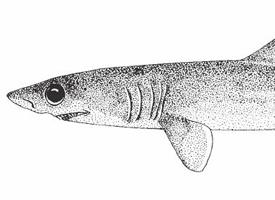
Description de l'animal
The Crocodile shark (Pseudocarcharias kamoharai) is a small and fascinating species of shark, belonging to the family Pseudocarchariidae. This unique species inhabits the deep waters of tropical and subtropical oceans worldwide, often dwelling near the edge of continental shelves. It is known for its distinctive physical features and elusive nature, making it a subject of interest among marine biologists and enthusiasts.One of the most striking characteristics of the Crocodile shark is its slender, elongated body, which can reach lengths of up to 1.1 meters (3.6 feet), although it is typically smaller. Its body is covered in small, smooth scales that give it a sleek appearance, facilitating its movement through the water with minimal resistance. The skin coloration is a deep blue to black on the dorsal side, transitioning to a lighter, almost white belly. This counter-shading serves as an effective camouflage in the open ocean, protecting the shark from predators and concealing it from prey.
The head of the Crocodile shark is somewhat flattened with a short, rounded snout. However, the most notable feature of its head is the large, green, luminous eyes that are adapted to the low light conditions of its deep-sea habitat. These eyes are among the largest in proportion to body size of any shark species, enhancing its vision in the dimly lit waters where it hunts.
The jaws of the Crocodile shark are equipped with long, needle-like teeth, which are visible even when the mouth is closed due to the lack of a full closure mechanism. This tooth arrangement is particularly effective for catching slippery prey such as squid and small fish, which constitute the majority of its diet. The shark's method of feeding is further aided by its ability to protrude its jaws and snap quickly at prey, a feature that has drawn comparisons to the snapping action of a crocodile, hence its common name.
In terms of behavior, Crocodile sharks are generally solitary and nocturnal. During the day, they remain in the deep waters, at depths of up to 590 meters (1,940 feet), to avoid predators and conserve energy. At night, they migrate vertically towards the surface in search of food, taking advantage of the cover of darkness to ambush prey.
Reproduction in Crocodile sharks is ovoviviparous, meaning the eggs develop and hatch inside the female's body, and the young are born fully formed. Females give birth to small litters, usually comprising two to four pups, which are relatively large and well-developed at birth, measuring about 40 centimeters (16 inches) in length. This reproductive strategy ensures a higher survival rate for the offspring, as they are born capable of fending for themselves.
Despite its fascinating biology, the Crocodile shark remains relatively unknown due to its deep-sea habitat and elusive nature. It is considered a species of least concern by the International Union for Conservation of Nature (IUCN), although like many deep-sea creatures, it faces threats from human activities such as deep-sea fishing and habitat destruction. Continued research and conservation efforts are essential to ensure the survival of this unique species and the health of the ecosystems it inhabits.
Nouvelles photos d'animaux
Top 10 des animaux
- Dolphin gull (Leucophaeus scoresbii)
- Diana monkey (Cercopithecus diana)
- Moustached guenon (Cercopithecus cephus)
- Galápagos tortoise (Geochelone nigra complex)
- Russian tortoise (Testudo horsfieldii)
- Japanese macaque (Macaca fuscata)
- Stone loach (Barbatula barbatula)
- Greek tortoise (Testudo graeca)
- Common flying dragon (Draco volans)
- Colossal squid (Mesonychoteuthis hamiltoni)